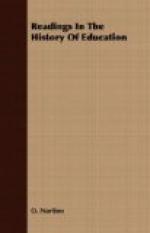The text and the “gloss,” or commentary, are here placed on opposing pages for the sake of clearness. The text is a compilation, chiefly from earlier compilations; Gratian did not as a rule consult the sources themselves. His pupil, Paucapalea, made many additions to the text, one of which appears in this selection. The gloss here translated is the standard commentary (glossa ordinaria) which was used for centuries in the regular university lectures (see p. 108). Like the text, it is a compilation from many sources. It was first made (c. 1212) by John the German (Joannes Teutonicus), who added his own notes—usually signed “John”—to his selections from earlier glossators. The names or titles, often abbreviated, of commentators whom he quotes are frequently appended to their notes, e.g. John of Fa[enza], Hugo [of Pisa], C[ardinalis], Lau[rentius Hispanus]; many notes are unsigned. About 1238 the compilation of John the German was revised and enlarged by Bartholomew of Brescia, who also added comments from other writers, e.g. Arc [hidiaconus]. This revision forms the greater part, if not the whole, of the gloss which appears below.
The cross-references, in the comments below, are left untranslated. They are mainly citations of other passages in the Decretum itself. Such references as XVI. quaest III. nemo are to be read, Case XVI, question III, in the section beginning Nemo; XLVIII dist. sit rector means Distinction XLVIII, in the section beginning Sit rector. Several of the references in this selection are incorrect.
The gloss on this page belongs to the first line of text on page 60. It forms, with the Summaries on later pages, a complete analysis of the text. It indicates, first, the five subdivisions of the distinctio; second, its general purport. Later summaries analyze small portions of the text. (Cf. the description of the lecture by Odofredus, p. 111.)
This division is divided into five sections; the second begins: “Then why ...” (p. 68); the third begins: “The report has come to as” (p. 74); the fourth begins: “Christians are forbidden” (p. 75); the fifth begins: “As therefore is evident” (p. 75). John of Fa.[A]




